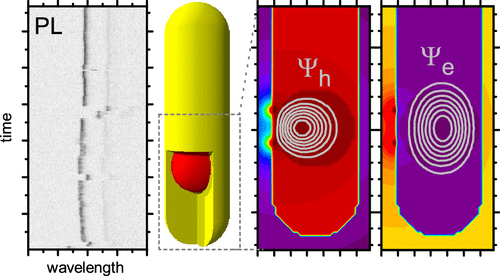Our official English website, www.x-mol.net, welcomes your feedback! (Note: you will need to create a separate account there.)
Surface Charges on CdSe-Dot/CdS-Rod Nanocrystals: Measuring and Modeling the Diffusion of Exciton-Fluorescence Rates and Energies
ACS Nano ( IF 17.1 ) Pub Date : 2017-11-21 00:00:00 , DOI: 10.1021/acsnano.7b05303 Sven-Hendrik Lohmann 1 , Christian Strelow 1 , Alf Mews 1 , Tobias Kipp 1
ACS Nano ( IF 17.1 ) Pub Date : 2017-11-21 00:00:00 , DOI: 10.1021/acsnano.7b05303 Sven-Hendrik Lohmann 1 , Christian Strelow 1 , Alf Mews 1 , Tobias Kipp 1
Affiliation

|
By performing spectroscopic single-particle measurements at cryogenic temperatures over the course of hours, we study both the spectral diffusion as well as the diffusion of the decay rates of the fluorescence emission of core/shell CdSe/CdS dot/rod nanoparticles. A special analysis of the measurements allows for a correlation of data for single neutral excitons only, undisturbed by the possible emission of other excitonic complexes. We find a nearly linear dependency of the fluorescence decay rate on the emission energy. The experimental data are compared to self-consistent model calculations within the effective-mass approximation, in which migrating point charges set onto the surface of the nanoparticles have been assumed to cause the temporal changes of optical properties. These calculations reveal a nearly linear relationship between the squared electron–hole wave function overlap, which is linked to the experimentally determined fluorescence rate, and the exciton emission energy. Within our model, single migrating surface charges are not sufficient to fully explain the measured rather broad ranges of emission rates and energies, while two—and in particular negative—surface charges close to the core of the DR induce large enough shifts. Importantly, for our nanoparticle system, the surface charges more strongly affect the hole wave function than the electron wave function and both wave functions are still localized within the dot-like core of the nanoparticle, showing that the type-I character of the band alignment between core and shell is preserved.
中文翻译:

CdSe-Dot / CdS-棒纳米晶体上的表面电荷:激子荧光速率和能量扩散的测量和建模
通过在几个小时内在低温下进行光谱单颗粒测量,我们研究了核/壳CdSe / CdS点/棒纳米颗粒的荧光发射的光谱扩散以及衰减速率的扩散。对测量值的特殊分析仅允许单个中性激子的数据相关,不受其他激子复合物可能发射的干扰。我们发现荧光衰减率与发射能量几乎呈线性关系。将实验数据与有效质量近似中的自洽模型计算进行比较,其中已假设设置在纳米颗粒表面的迁移点电荷会引起光学性质的时间变化。这些计算揭示了平方的电子-空穴波函数重叠(与实验确定的荧光速率相关)和激子发射能之间的近似线性关系。在我们的模型中,单次迁移的表面电荷不足以完全解释所测得的相对较大的发射速率和能量范围,而靠近DR核心的两个表面电荷(尤其是负电荷)则引起足够大的偏移。重要的是,对于我们的纳米粒子系统,表面电荷对空穴波功能的影响比对电子波函数的影响更大,并且两个波函数仍位于纳米粒子的点状核内,这表明能带排列的I型特征保留核心与外壳之间的位置。这与实验确定的荧光率和激子发射能量有关。在我们的模型中,单次迁移的表面电荷不足以完全解释所测得的相对较大的发射速率和能量范围,而靠近DR核心的两个表面电荷(尤其是负电荷)则引起足够大的偏移。重要的是,对于我们的纳米粒子系统,表面电荷对空穴波功能的影响比对电子波函数的影响更大,并且两个波函数仍位于纳米粒子的点状核内,这表明能带排列的I型特征保留核心与外壳之间的位置。这与实验确定的荧光率和激子发射能量有关。在我们的模型中,单次迁移的表面电荷不足以完全解释所测得的相对较大的发射速率和能量范围,而靠近DR核心的两个表面电荷(尤其是负电荷)则引起足够大的偏移。重要的是,对于我们的纳米粒子系统,表面电荷对空穴波功能的影响比对电子波函数的影响更大,并且两个波函数仍位于纳米粒子的点状核内,这表明能带排列的I型特征保留核心与外壳之间的位置。单次迁移的表面电荷不足以完全解释测得的相当宽的发射速率和能量范围,而靠近DR核心的两个表面电荷(尤其是负电荷)则引起足够大的偏移。重要的是,对于我们的纳米粒子系统,表面电荷对空穴波功能的影响比对电子波函数的影响更大,并且两个波函数仍位于纳米粒子的点状核内,这表明能带排列的I型特征保留核心与外壳之间的位置。单次迁移的表面电荷不足以完全解释测得的相当宽的发射速率和能量范围,而靠近DR核心的两个表面电荷(尤其是负电荷)则引起足够大的偏移。重要的是,对于我们的纳米粒子系统,表面电荷对空穴波功能的影响比对电子波函数的影响更大,并且两个波函数仍位于纳米粒子的点状核内,这表明能带排列的I型特征保留核心与外壳之间的位置。
更新日期:2017-11-21
中文翻译:

CdSe-Dot / CdS-棒纳米晶体上的表面电荷:激子荧光速率和能量扩散的测量和建模
通过在几个小时内在低温下进行光谱单颗粒测量,我们研究了核/壳CdSe / CdS点/棒纳米颗粒的荧光发射的光谱扩散以及衰减速率的扩散。对测量值的特殊分析仅允许单个中性激子的数据相关,不受其他激子复合物可能发射的干扰。我们发现荧光衰减率与发射能量几乎呈线性关系。将实验数据与有效质量近似中的自洽模型计算进行比较,其中已假设设置在纳米颗粒表面的迁移点电荷会引起光学性质的时间变化。这些计算揭示了平方的电子-空穴波函数重叠(与实验确定的荧光速率相关)和激子发射能之间的近似线性关系。在我们的模型中,单次迁移的表面电荷不足以完全解释所测得的相对较大的发射速率和能量范围,而靠近DR核心的两个表面电荷(尤其是负电荷)则引起足够大的偏移。重要的是,对于我们的纳米粒子系统,表面电荷对空穴波功能的影响比对电子波函数的影响更大,并且两个波函数仍位于纳米粒子的点状核内,这表明能带排列的I型特征保留核心与外壳之间的位置。这与实验确定的荧光率和激子发射能量有关。在我们的模型中,单次迁移的表面电荷不足以完全解释所测得的相对较大的发射速率和能量范围,而靠近DR核心的两个表面电荷(尤其是负电荷)则引起足够大的偏移。重要的是,对于我们的纳米粒子系统,表面电荷对空穴波功能的影响比对电子波函数的影响更大,并且两个波函数仍位于纳米粒子的点状核内,这表明能带排列的I型特征保留核心与外壳之间的位置。这与实验确定的荧光率和激子发射能量有关。在我们的模型中,单次迁移的表面电荷不足以完全解释所测得的相对较大的发射速率和能量范围,而靠近DR核心的两个表面电荷(尤其是负电荷)则引起足够大的偏移。重要的是,对于我们的纳米粒子系统,表面电荷对空穴波功能的影响比对电子波函数的影响更大,并且两个波函数仍位于纳米粒子的点状核内,这表明能带排列的I型特征保留核心与外壳之间的位置。单次迁移的表面电荷不足以完全解释测得的相当宽的发射速率和能量范围,而靠近DR核心的两个表面电荷(尤其是负电荷)则引起足够大的偏移。重要的是,对于我们的纳米粒子系统,表面电荷对空穴波功能的影响比对电子波函数的影响更大,并且两个波函数仍位于纳米粒子的点状核内,这表明能带排列的I型特征保留核心与外壳之间的位置。单次迁移的表面电荷不足以完全解释测得的相当宽的发射速率和能量范围,而靠近DR核心的两个表面电荷(尤其是负电荷)则引起足够大的偏移。重要的是,对于我们的纳米粒子系统,表面电荷对空穴波功能的影响比对电子波函数的影响更大,并且两个波函数仍位于纳米粒子的点状核内,这表明能带排列的I型特征保留核心与外壳之间的位置。

























 京公网安备 11010802027423号
京公网安备 11010802027423号